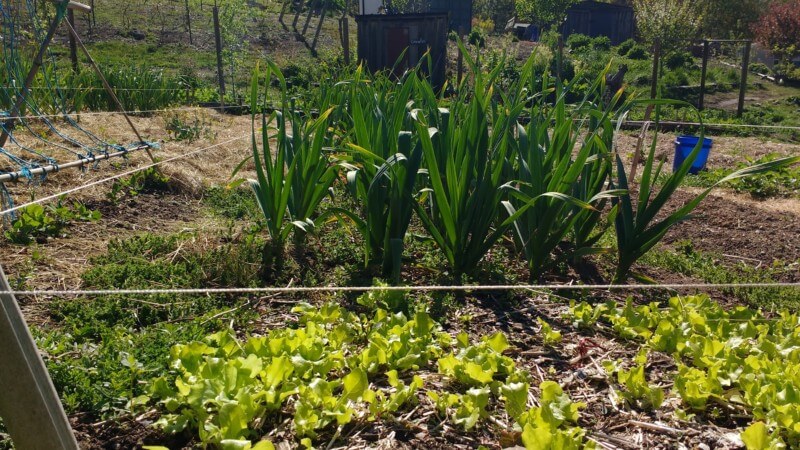Self-sufficiency gardening from your vegetable and herb garden. Self-sufficiency gardening is a well-known question I receive when people notice my veggies garden. They ask, do I need to purchase any vegetables and herbs with that much growing? You may be shocked to understand that I always answer yes.
There is some stuff I love to consume frequently that I can’t grow in our climate, will simply plant at specific times of the year or do not yield enough for the place.
But there are many tricks I use in striving for self-sufficiency in vegetables and herbs and I wanted to share those with you by focusing on my favorite crops.
I determine a favorite crop by how often we have it in our diet, the yield for the space, ease of growing and suitability for our climate.
My tricks of self-sufficiency in vegetables and herbs in our subtropical weather are as follows …
1.Lettuce.
easy for self-sufficiency gardening.
it can easily be planted in the sun for seven months of the year and in the summertime in partial shade, which indicates twelve months of gardening so long as I have the water up.
I plant lettuce every month and relocate them throughout my garden to follow a rotation pattern. Lettuces are very productive for the place they take up.
usually, We do not collect the lettuce heads, we pick leaves every day, meaning we waste nothing. usually, we do not need to purchase lettuces and we eat lettuce at least 3 times per week.
You can plant about twelve lettuces in a 1 m2. In a cooler environment, use a glasshouse or greenhouse for lettuce growing.
2.Spring onion.
I usually plant them every month and use them within spaces and as a partner plant for lots of crops. Its astonishing how many plants you can have in a tiny space.
They are slow-growing, however, if you plant each month, there is always something you can harvest.
Sometimes we remove the whole plant and other times only some the green tops so it keeps growing.
We never purchase spring onions. You can grow at least 50 spring onions in a 1 m2 and in our climate they can be planted for 8 months in sun and 4 months in partial shade in the hotter months.
It is fiddly but usually plants these separately by pulling apart multiple plants often together in a seed pot.
3.Leeks
We produce 4 plantings of leeks per year from April to August and plant about 50 every time.
You can easily plant about 20-30 per m2. They happen to be slow growers but we end up having them from the garden for nearly 8 months of the year. Leeks regularly thrive with reasonable soil and enough moisture
4.Peas and beans
Peas are autumn to spring crops in our environment and beans are autumn to early winter and spring to an early summer crop.
we regularly have either one of these crops going in the garden and use climbing varieties on frames to maximize the growth for the area used.
we usually have 3 to 4 plantings of each in the year, say every two months depending on the crop and this gives peas or beans for most of the year.
January to March is a little bit lean, however, we have learned that snake beans perform properly throughout this intense weather time.
For 1 m2 of ground space and a climbing frame of 4 m2 (1.3 x 3), furthermore, you can produce a large crop from 3 to 4 plants
5. Cooking greens
We constantly have a mixture growing in our gardens and for most of the year, we do not purchase cooking greens. Our usual common crop mix includes kale, Choi sum, rainbow chard, and silverbeet.
These are whole greens that you can continue harvesting from as you need leaves each day. based on my experience, I have harvested for up to seven months from one plant before it goes to seed.
be certain the water is kept up to them so the leaves stay fat and the soil vitality is strong. You can grow about six of these crops to an m2. If it becomes too hot, shade them.
the previous year, I planted out all of these crops in an 8 m bed of ours and it was 40C a week after planting.
I made sure to shad these for a month until it cooled down and the crops thrived for the next five months.
6.Carrots
even tho carrots are not the most comfortable crop to grow in our climate, once you get the trick of how to grow them, they are a radical producer for a tiny amount of space. in only one 5 m2 bed, we produced 500 good sized carrots the previous year.
We have 2-3 planting every year with the last harvest in December and the first harvest in the following year starting in May. Therefore we get about six months of carrots and usually store them in the ground, i.e.
we don’t harvest till we use them. Recommend always seeding the carrots directly.
Authored by Peter Kearney
7.COFFEE GROUNDS
Coffee is a stimulant also for plants. you heard it, your coffee grounds can help your plants grow because the grounds are acidic.
did you know that The acidic nature of the grounds is perfect to use for roses, blueberry bushes, and evergreens§? you are not only giving your plants a natural fertilizer.
you’ll also reduce your waste by not throwing the coffee grounds in the trash.
8.watering
make sure to water your garden early mornings to conserve moisture loss and to help avoid powdery mildew and other fungal diseases that are often spread by high humidity levels.
be aware! Overwatering is more harmful than underwatering. you probably recognize that It is easier to revive a dry plant than try to dry out drowned roots.

